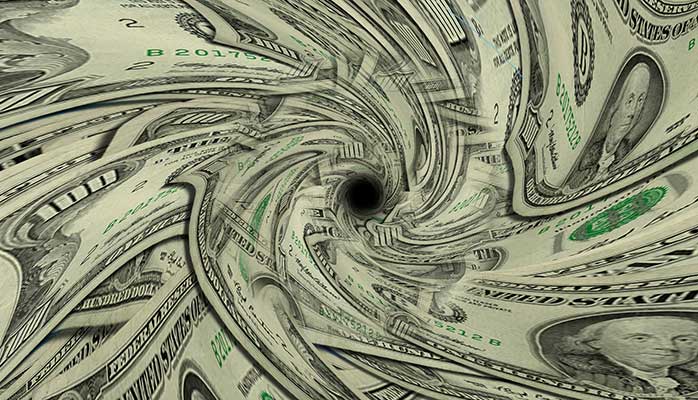8 Ways to Waste Money on Printing

So you need printing – a book, a brochure, a point-of-sale display or a mailer. Whatever it is, you want a quality piece that reflects well on your brand and business. But with all of the production options available, how do you know what’s worthwhile and what’s not?
Printing is a complex. With over 35,000 firms offering differing equipment and capabilities, navigating the U.S. printing marketplace can be challenging. Depending on the design of the piece, some print options can be valuable. Others are waste of money.
When planning your next printed piece, consider these eight factors that can add significant cost to your next project. Some may be worth it, others are definitely not.
1. Size: Printing presses are built to specific dimensions and printing papers are stocked in commonly used sizes. Unusually sized pieces may not fit well within these standards, wasting paper and not fully utilizing press capacity. So to avoid inefficiency, a printed piece should be designed to fit well within the fixed dimensions of the equipment and materials.
Case in point. A client asked us to produce header cards to be mounted on an in-store display. On review of their previous work, we found that a slight reduction in size allowed us to print two cards simultaneously instead of one. This significantly lowered cost while maintaining the header’s effectiveness.
2. Equipment: Printers make significant investments in facilities so they have a vested interest in keeping their equipment busy. However, all printing presses are optimized to specific sizes and run lengths. While a project can be printed on one type of press, it may be more efficient to print it on another. A commercial sheetfed offset press can easily run 1 million flyers, but it’s usually more cost effective to print them on a web press.
3. Brand name paper: A specific substrate can make a big difference in the quality of a printed piece, particularly specialty materials, unique colors or custom finishes. But other times this makes no difference at all. Most printers inventory common paper sizes and weights and they usually purchase in bulk. Specifying a “name brand” paper, with no special characteristics, requires an expensive special order that often adds little to the quality. Before incurring this expense, ask your printer for a sample of their recommended “house” sheet – it may be perfect for your project.
4. Spot colors: Tight color matching, or use of unique colors, can be an important part of design. Sometimes, this requires printing spot colors as separate inks. Other times, these colors can be closely matched using combinations of CMYK process colors. Printing presses can only run a fixed number of inks simultaneously; several special inks may require multiple passes, or runs of the paper, through the press, at extra cost. Before requiring multiple spot colors, be certain they cannot be matched adequately in four color CMYK process.
5. Quantity ordered: Minimizing the print quantity may save a few dollars but, if stock runs out, additional pieces will require a reprint. Startup of an offset press requires a preparation process called the makeready. Since makereadies are incurred for each reprint, this additional cost would not be necessary if the initial quantity was adequate. When purchasing offset printing, carefully consider the quantity of each piece over its lifespan, then order as many as you’ll need.
Note this advice is most applicable to traditional printing methods as short run-digital printing does not require a significant makeready.
6. Printing everything at once: Projects that include multiple items may be less costly if several are printed at the same time. Combining, or gang running, items together can be more efficient since it requires only one makeready and press run for all pieces. Short run digital printing, as before, may be an exception to this rule.
7. Proofreading and QC: Lack of quality control can lead to mistakes that require reprints, which often cost as much as the original printing. Recently I saw the following display installed in a local supermarket, check out the typo in the headline:

Since taking this photo the display has been replaced with a corrected one, likely requiring significant expense for the reprint. To avoid this, take the time to review artwork and proofs to assure all everything is correct before printing.
8. Execution, logistics and final use: Before printing anything, consider how it will be used. Effective print communications, like any media, must deliver a valuable, instructional or actionable message to the intended target or it will not achieve its purpose. Efficient production will not compensate for a lack of planning.
I recently heard of a consumer products company that produced a booklet designed to look like a passport on the outside. Inside, its pages featured various lifestyle messages about the brand. The firm intended to seed these pieces around the marketplace, enticing the consumer to pick one up and read the contents. However, they didn’t have a plan to distribute them efficiently. As a result, most of the pieces sat in the warehouse and were eventually disposed of.
Experienced print buyers will find most of this advice elementary as experience teaches how to fit projects to the appropriate supplier then efficiently manage and monitor the process. Yet many firms that purchase a significant volume of printing no longer have this expertise in-house.
If any of these pain points are familiar, or you’re not certain you’re purchasing printing efficiently, feel free to reach out. We’re happy to be of help.

Leave a Reply